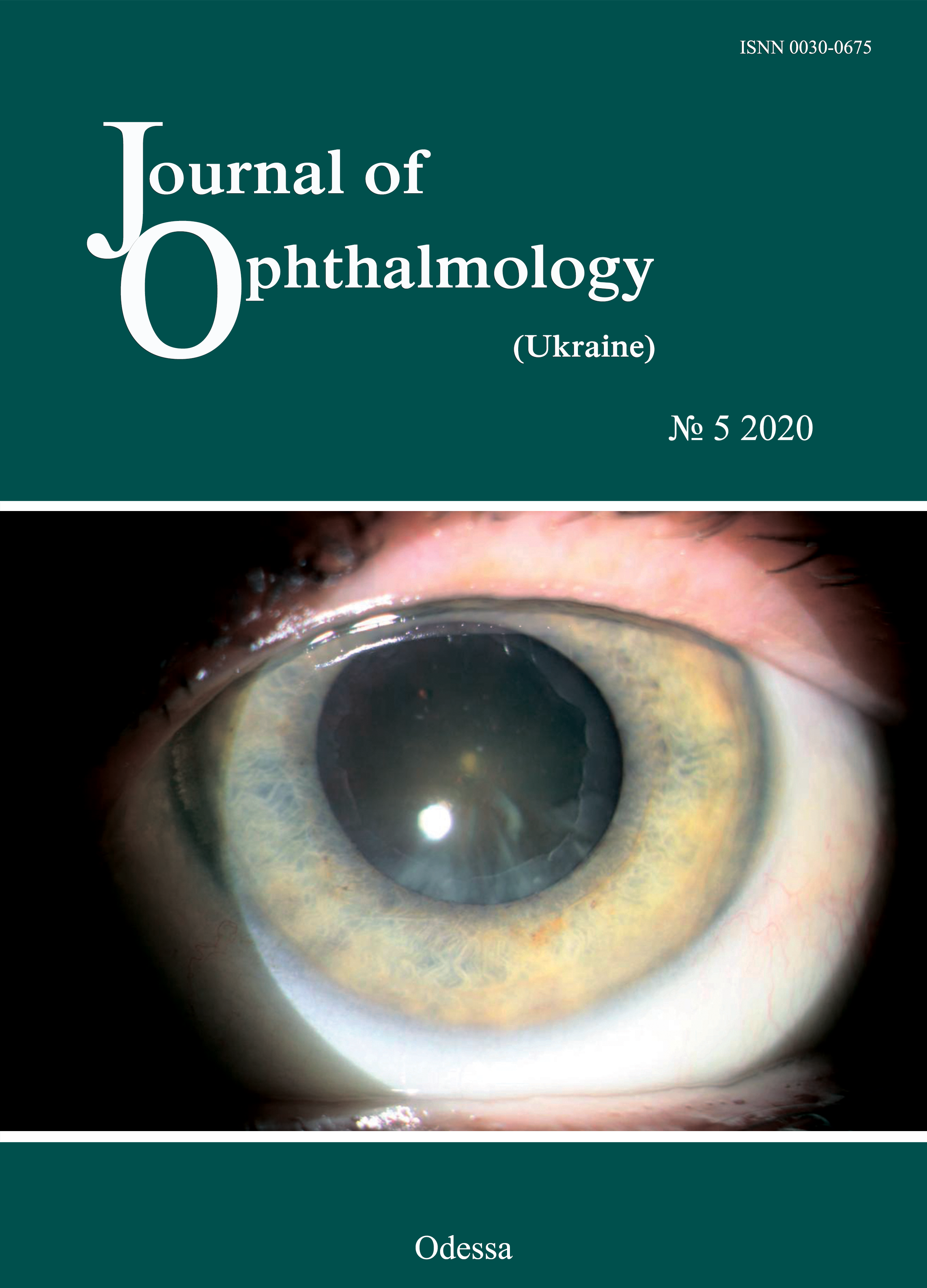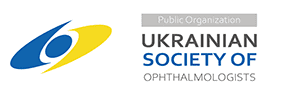Neuro-ophthalmological abnormalities in patients with ischemic stroke in the setting of a stroke center of a university clinic
DOI:
https://doi.org/10.31288/oftalmolzh202055661Keywords:
neuroophthalmology, stroke, diagnosisAbstract
Background: Stroke remains one of the leading causes of death and disability in the world. Most patients with stroke exhibit neuro-ophthalmological abnormalities.
Purpose: To assess the frequency of neuro-ophthalmological abnormalities in patients with stroke in the setting of a stroke center of a university clinic.
Material and Methods: Two hundred and ninety-eight patients with acute ischemic cerebrovascular accidents who were under observation at the stroke service of the Neurology Department of the Center for Reconstructive and Restorative Medicine (University Clinic) of the Odesa National Medical University from January 2016 through December 2019 were included in the study. Frequency of neuro-ophthalmological symptoms was assessed at the first neurological examination visit and after ophthalmologist consultation was obtained.
Results: Of the 298 patients with stroke, most (162; 54%) were men. Mean patient age was 60.4 ± 1.1 years and mean National Institutes of Health Stroke Scale (NIHSS) score was 10.1 ± 0.9. In addition, of the 298 patients, 163 (54.7%) were admitted to the clinic within a day after onset of clinical symptoms of a stroke. Stroke syndromes were categorized into four subtypes, total anterior circulation infarcts (TACI), partial anterior circulation infarcts (PACI), lacunar circulation infarcts (LACI), and posterior circulation infarcts (POCI). PACI were the most common (139 cases or 36.6%), followed by LACI (88 cases or 29.5%), whereas TACI were least common (28 cases or 10.5%). Of special interest were POSI (43 cases or 14.4%). Fourteen patients with POSI (4.7% of the total study patients) had lesions of the midbrain and pons. Neuro-ophthalmological manifestations were found in 88.8% of patients. Of these manifestations, anisocoria was the most common (60.1%), followed by hemianopia (27.9%), diplopia (22.1%) and visuospatial neglect (19.5%), and various oculomotor abnormalities. Internuclear ophthalmoplegia (INO) was found only in 8 cases (2.7%).
Conclusion: Diagnosing neuro-ophthalmological syndromes requires coordinated efforts of the neurologist and ophthalmologist in the setting of a multi-professional team.
References
1.Muratova T, Khramtsov D, Stoyanov A, Vorokhta Y. Clinical epidemiology of ischemic stroke: global trends and regional differences. Georgian Med News. 2020 Feb;(299):83-6.
2.Norrving B, Barrick J, Davalos A, Dichgans M, Cordonnier C, Guekht A, et al. Action Plan for Stroke in Europe 2018-2030. Eur Stroke J. 2018 Dec;3(4):309-36. https://doi.org/10.1177/2396987318808719
3.Dutta D, Hellier K, Obaid M, Deering A. Evaluation of a single centre stroke service reconfiguration - the impact of transition from a combined (acute and rehabilitation) stroke unit to a hyperacute model of stroke care. Future Healthc J. 2017 Jun;4(2):99-104.https://doi.org/10.7861/futurehosp.4-2-99
4.Rowe FJ; VIS Group. Accuracy of referrals for visual assessment in a stroke population. Eye (Lond). 2011 Feb;25(2):161-7.https://doi.org/10.1038/eye.2010.173
5.Sacco RL. Stroke Vision 2020: Creating a Roadmap for the Next Decade. Stroke. 2020 Mar;51(3):1040-6.https://doi.org/10.1161/STROKEAHA.120.028423
6.Klyushnikov SA, Aziatska GA. [Oculomotor disorders in neurological practice]. Nervnyie bolezni. 2015; 4:41-6. Russian.
7.Rowe FJ, Conroy EJ, Barton PG, Bedson E, Cwiklinski E, Dodridge C, et al. A Randomised Controlled Trial of Treatment for Post-Stroke Homonymous Hemianopia: Screening and Recruitment. Neuroophthalmology. 2016 Jan 19;40(1):1-7.https://doi.org/10.3109/01658107.2015.1126288
8.Hanna KL, Rowe FJ. Health Inequalities Associated with Post-Stroke Visual Impairment in the United Kingdom and Ireland: A Systematic Review. Neuroophthalmology. 2017 Mar 1;41(3):117-136.https://doi.org/10.1080/01658107.2017.1279640
9.Walle KM, Nordvik JE, Becker F, Espeseth T, Sneve MH, Laeng B. Unilateral neglect post stroke: Eye movement frequencies indicate directional hypokinesia while fixation distributions suggest compensational mechanism. Brain Behav. 2019 Jan;9(1):e01170.https://doi.org/10.1002/brb3.1170
10.Gorbulina VS, Zatei AO. [Ways to improve neuroophthalmology]. Alleia nauki. 2018;3(7):54-7. Russian.
11.[Order of the Ministry of Health of Ukraine No. 602 issued on 3.08.2012 "On approval and implementation of medical and technological documents on standardization of medical care for ischemic stroke", as amended and supplemented by Order No. 34 of the Ministry of Health of Ukraine of 15.09.2014]. Access mode: http://search.ligazakon.ua/l_doc2.nsf/link1/MOZ16323.html. Ukrainian.
12.Jadhav AP, Mokin M, Ortega-Gutierrez S, Haussen D, Liebeskind D, Nogueira R, et al. An Appraisal of the 2018 Guidelines for the Early Management of Patients with Acute Ischemic Stroke. Interv Neurol. 2020 Feb;8(1):55-9.https://doi.org/10.1159/000495041
13.Warner JJ, Harrington RA, Sacco RL, Elkind MSV. Guidelines for the Early Management of Patients With Acute Ischemic Stroke: 2019 Update to the 2018 Guidelines for the Early Management of Acute Ischemic Stroke. Stroke. 2019 Dec;50(12):3331-3332.https://doi.org/10.1161/STROKEAHA.119.027708
14.Markdorf SA, Predtechenskaya EV, Savelov AA, Tulupov AA, Shtark MB. [Neuroimaging and cerebral infarction (stroke)]. Uspekhi fiziologicheskikh nauk. 2018; 49(2): 60-71. Russian.
15.Elkind MS. Stroke Etiologic Classification-Moving From Prediction to Precision. JAMA Neurol. 2017 Apr 1;74(4):388-90.https://doi.org/10.1001/jamaneurol.2016.5926
16.Gustov AV, Takhtaev IuV, Sigrianskii KI, Murzin VA. [Practical neuroophthalmology: a guide for doctors]. Nizhnii Novgorod: Publishing House of Nizhnii Novgorod State Medical Academy; 2011. Russian.
17.Khalafian A.A. [Industrial statistics: Quality control, process analysis, experiment planning in the STATISTICA package]. Moscow: Librocom, 2013. Russian.
18.Blumenfeld H. Neuroanatomy through clinical cases. 2nd ed. Sunderland, MA: Sinauer Associates; 2010.
19.Vázquez-Justes D, Martín-Cucó A, Gallego-Sánchez Y, Vicente-Pascual M. WEBINO syndrome (wall-eyed bilateral internuclear ophthalmoplegia) secondary to ischemic stroke, about a case. Arch Soc Esp Oftalmol. 2020 Apr;95(4):205-208.https://doi.org/10.1016/j.oftale.2019.12.008
20.Vynckier J, Lemmens R. Torsional internuclear ophthalmoplegia in acute ischemic stroke. Neurol Clin Pract. 2019 Apr;9(2):168-9.https://doi.org/10.1212/CPJ.0000000000000569
21.Hanna KL, Rowe FJ. Clinical versus Evidence-based Rehabilitation Options for Post-stroke Visual Impairment. Neuroophthalmology. 2017 Jul 6;41(6):297-305.https://doi.org/10.1080/01658107.2017.1337159
Downloads
Published
How to Cite
Issue
Section
License
Copyright (c) 2025 Т. М. Муратова, Л. В. Венгер, Д. М. Храмцов, Ю. М. Ворохта, В. Д. Телющенко

This work is licensed under a Creative Commons Attribution 4.0 International License.
This work is licensed under a Creative Commons Attribution 4.0 International (CC BY 4.0) that allows users to read, download, copy, distribute, print, search, or link to the full texts of the articles, or use them for any other lawful purpose, without asking prior permission from the publisher or the author as long as they cite the source.
COPYRIGHT NOTICE
Authors who publish in this journal agree to the following terms:
- Authors hold copyright immediately after publication of their works and retain publishing rights without any restrictions.
- The copyright commencement date complies the publication date of the issue, where the article is included in.
DEPOSIT POLICY
- Authors are permitted and encouraged to post their work online (e.g., in institutional repositories or on their website) during the editorial process, as it can lead to productive exchanges, as well as earlier and greater citation of published work.
- Authors are able to enter into separate, additional contractual arrangements for the non-exclusive distribution of the journal's published version of the work with an acknowledgement of its initial publication in this journal.
- Post-print (post-refereeing manuscript version) and publisher's PDF-version self-archiving is allowed.
- Archiving the pre-print (pre-refereeing manuscript version) not allowed.












